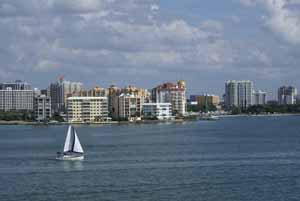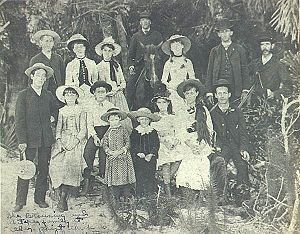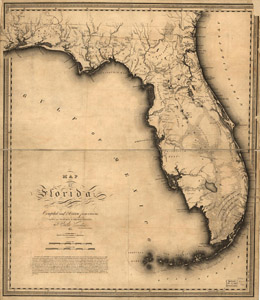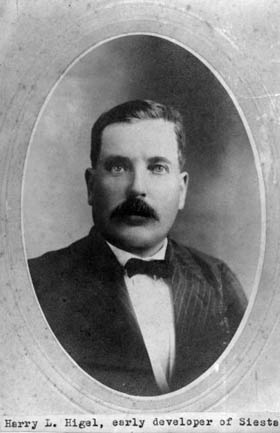Sarasota’s Rich History Pt.1

Sarasota, Florida, has a unique lifestyle that attracts people from all over the U.S. who are drawn to the area’s favorable climate and appealing real estate. Indeed, there’s always something to smile about when you call Sarasota home. The city and its surrounding towns, which include Venice and Bradenton, are a Mecca for residents with sophisticated tastes, cultured backgrounds, and diverse interests. The energy of the region can’t help but put you in good spirits, and the multifaceted market will make your home buying or selling experience a pleasure, whether you are a part-time resident or a year-round dweller. Behind a beautiful tropical landscape is a fascinating history. It weaves together a unique community fabric that blankets neighboring Sarasota and Manatee Counties in intriguing charm, making them among the most desirable places to live in Florida.
Sarasota is the crown jewel of the state’s southwest coast. From its crushed quartz crystal beach on Siesta Key to its rich heritage and interesting founders, the city has become a luxurious haven that offers a wide range of distinctive lifestyle choices and communities. Surrounded with beautiful barrier islands including Lido Key, St. Armands Key, Longboat Key, and Siesta Key, Sarasota’s current footprint is 26 square miles and the metro area population is around 673,035, with an estimated 52,488 living inside the city limits, according to 2007 statistics from the U.S. Census Bureau.
The city design was enhanced in 1927 by professional planner John Nolan (who also is noted for planning the layout of Venice) to follow the arch of the bay front. The city hall was located in an arcade at the end of Main Street at the waterfront, and it connected with the city dock. This central hub design, which became unmanageable with an increasing number of automobiles, was cast off in the 1960s with the demolition of city hall and reengineering of the streets to handle more traffic flow. New Urbanism concepts were adopted in the wake of the changes, which focused on developing a pedestrian-friendly city. Today, downtown Sarasota is an oasis of quaint shopping and restaurants centered on Main Street, which leads to a scenic marina overlooking the bay and the John Ringling Bridge. Dotted with luxurious condos and quaint historic neighborhoods such as Laurel Park, the heart of the city gives way to some of the best planned communities on the Gulf Coast of Florida, including Palmer Ranch to the south and Lakewood Ranch to the northeast.
Pioneers Plant Humble Roots

Far removed from today’s exclusive golf course neighborhoods, bay front properties, and beach estates, Sarasota’s community foundation stretches all the way back to the late 1800s, when the “modern town” was promoted in Scotland by the Florida Mortgage and Investment Company, according the Sarasota Convention and Visitor’s Bureau. While the town was little more than a frontier camp, it attracted many families looking for affordable living and fertile land to grow citrus.
William Whitaker was Sarasota’s first documented pioneer of European ancestry. Born in Savannah, Georgia, in 1821, he made his home on Yellow Bluffs, which is north of Eleventh Street, and began selling dried fish to traders who worked the coast. He began a cattle business in 1847 and then married Mary Jane Wyatt, whose family settled the village of Manatee. Together they had 11 children and weathered a harsh life, which included surviving an Indian raid that devastated their home.
They were later joined by John Webb and his family, who moved from Utica, New York, to Florida in 1867. First landing in Key West, they were directed to Sarasota by a Spanish trader who informed them of a high bluff ideal for homesteading. Upon arriving, the Webbs met Whitaker, who knew the exact spot they were seeking. It was located several miles south on Little Sarasota Bay. There they established a homestead and called it Spanish Point in honor of the trader, and they began growing citrus, sugar cane, and vegetables. The family built a packing house to prepare the produce and fruits for market, as well as a 10-ton schooner to transport the goods. John Webb became a postmaster in 1881 and selected the name Osprey for the town, which today houses Historic Spanish Point, a 30-acre historical, archaeological, and environmental museum.

Before it was Siesta Key, the small barrier island off the coast of Florida was known by several other names: Sarasota Key, from the Amerindian word Zarazote, Clam Island, “Muscle” Island, Palm Island and Little Sarasota Island. European cartographers referred to it as Sarasota Key when exploration began in the year 1513, and maps dating back to the earlier part of the 18th century, including local maps dated earlier than the 1920s use the name Sarasota Key. It wasn’t until this time—the 1920’s—that Sarasota Key was renamed Siesta Key.
The colonization of the then Sarasota Key took place in 1846, and by the late 19th century—around 1880, the first homesteaders settled in the previously uninhabited Sarasota Key. Life was hard on the island, and only a few families stayed long enough to establish their claims. A few beach homes were built—Siesta Key was not a tourist destination then—and those who were particularly resilient lived there for the entire year. Most of the residents were fishermen who had arrived with their families.
Of the residents that established themselves on Sarasota Key in the 1880s, one of the most notable was Captain Louis Roberts and his wife Ocean Hansen Roberts. Captain Roberts is credited with opening the first hotel in Sarasota Key. One day in 1906, Captain Roberts, together with his wife, enlarged his boarding house to accommodate more rooms, naming it the Roberts Inn. This early landmark also became known as the Siesta Inn. They housed northern visitors who came to the island for winter, and soon the hotel garnered a certain amount of fame for Mrs. Roberts’ delicious seafood cooking. In later years Mrs. Roberts’ delectable island cuisine recipes and the white sandy beaches had gained enough of a reputation to draw several high-profile visitors to the Siesta Inn; many visitors from the East coast came to Siesta Key to dine on Mrs. Roberts’ seafood delights. Bette Davis, Charlton Heston, Cecil B. DeMille and Agness Moorehead were only a few of the Hollywood crowd that came visit.
The year after the opening of the Roberts Hotel, Captain Roberts, together with his friends Harry Higel and E.M. Arbogast formed the Siesta Land Company, made a plat of Siesta Village, and renamed the island to Siesta Key. Harry Higel was, at that time, the mayor of Sarasota and a wealthy land developer. He made a notable effort to promote Siesta Village, advertising properties in Siesta Village, and looking for ways to further develop and improve the island, making it more attractive to possible customers.

The Bay Island Hotel opened in 1912, further establishing Siesta Key’s status as a budding tourist destination. Called the largest and most beautiful hotel on Florida’s west coast, the Bay Island Hotel continued to be in business until the 1940s when it was closed down by the owner concerned with its “morality”. It was rumored the hotel was operating as an “after hours” club that served alcoholic drinks. Unfortunately this historical siesta key hotel burned to the ground in 1952.

In 1914, Harry Higel opened his own hotel, which he named Higelhurst. It was located on the northern end of the Key, along the shore at Big Pass. Higel realized that the inaccessibility of the island was a factor hindering Siesta Key’s development. His solution was to run a boat across the water to the mainland Sarasota, ferrying guests back and forth. Eventually, Higel contracted the Army Corp of Engineers to build a bridge stretching from Sarasota to Siesta Key, which opened in 1917.
By 1940, Siesta Key’s population had grown to only about 300. Before the Depression, and even after, the little island’s development gradually slowed down. Siesta Key was a popular destination for artists and creative people, and by 1955, more than 70 established artists, among them Thornton Utz, VT Hamlin and Syd Solomon, had themselves become residents.
Today, Siesta Key continues to be a beacon to wealthy homeowners, who, since the 1900s have helped develop the island’s rich heritage—both culturally as well as architecturally. From a quaint fishing encampment to a prime tourist destination and cultural hub, Siesta Key has grown to a population of 15,000 residents, with around 18,000 additional people coming for the winter months. Various residences dot the palm-lined beaches and neighborhoods, ranging from waterfront condominiums to luxury private homes.
Contact Christina Miller
You can contact me by either:
Phone: 941-713-2340
Skype: "sarasotabay"
By Email:
Christina Miller
Sarasota Bay Real Estate
2033 Main Street Suite 104
Sarasota, Florida
34237
- Christina Miller, Broker and Owner of Sarasota Bay Real Estate, 2033 Main Street Suite 104, Sarasota Florida, 34237 - Direct line: (941) 713-2340
